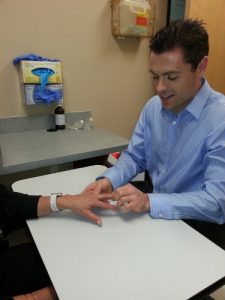What is Carpal Tunnel Syndrome?
- What is the Carpal Tunnel?
- What is Treatment for Carpal Tunnel Syndrome Like?
- What is a Carpal Tunnel Release?
One of the most common causes of numbness in the hand is carpal tunnel syndrome. Think of it as a pinched nerve in the wrist. Patients often complain of numbness in the thumb, index, middle and ring fingers. This usually affects people at night in their sleep, or during the day with prolonged grip or repetitive motion activities. It can cause weakness of the hand in more advanced cases.
What is the Carpal Tunnel?
The carpal tunnel refers to a channel in the wrist where nine tendons and the median nerve travel. It is a confined space, consisting of bony walls with a ligament roof. Conditions that lead to inflammation of the tendons cause swelling and can take up more space (diabetes, trauma, rheumatoid arthritis, kidney disease, pregnancy), leaving less room for the nerve to get blood flow. When this happens, the nerve cannot work and numbness results.
What is Treatment for Carpal Tunnel Syndrome Like?

Dr. Riggenbach with a patient.
Treatment for carpal tunnel syndrome is usually an outpatient procedure. The recovery is usually very rapid, with most patients able to move their fingers and wrist right away.
The diagnosis can usually be made with a history and physical exam performed by a medical professional, but often times a nerve conduction study is needed to confirm that the nerve problem is at the wrist and not elsewhere, such as in the neck.
Treating carpal tunnel in its mild form may only require a splint which is worn at nighttime. The splint keeps the wrist in a neutral position to prevent increased pressure on the nerve. Modifying activity to avoid positions that may aggravate the numbness is also encouraged. Steroid injections can help decrease inflammation around the nerve, and while symptoms may go away completely, the effect may only be temporary.
What is a Carpal Tunnel Release?
If carpal tunnel is persistent or more severe, then a carpal tunnel release is recommended. This requires consultation with surgeon, preferably a Hand specialist. This procedure is usually an outpatient procedure done with minimal anesthesia and only takes 15-20 minutes.
The recovery is usually very rapid, with most patients able to move their fingers and wrist right away. Pain in the palm can last for weeks to months after surgery and is most aggravated by heavy gripping, lifting or weight bearing on the hand. If carpal tunnel is not severe, a full recovery is expected, with full grip strength returning by three months.
Written by Michael D. Riggenbach, M.D.


